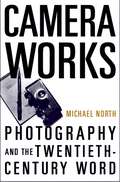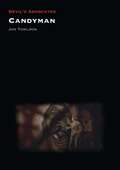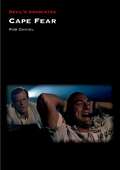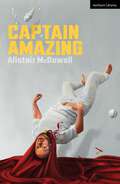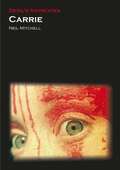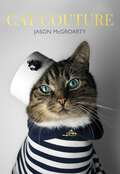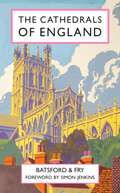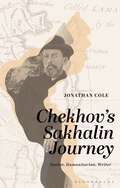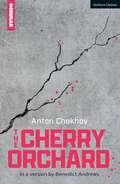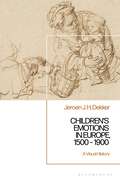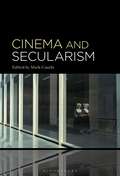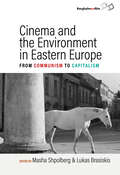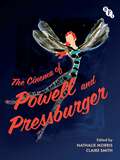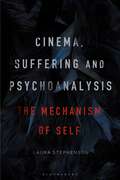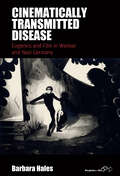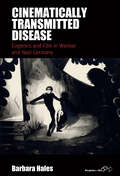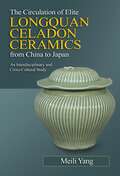- Table View
- List View
Candyman (Devil's Advocates)
by Jon TowlsonWhen Candyman was released in 1992, Roger Ebert gave it his thumbs up, remarking that the film was “scaring him with ideas and gore, rather than just gore.” Indeed, Candyman is almost unique in 1990s horror cinema in that it tackles its sociopolitical themes head on. As critic Kirsten Moana Thompson has remarked, Candyman is "the return of the repressed as national allegory": the film’s hook-handed killer of urban legend embodies a history of racism, miscegenation, lynching, and slavery, "the taboo secrets of America’s past and present."In this book, Jon Towlson considers how Candyman might be read both as a "return of the repressed" during the George H. W. Bush era, and as an example of nineties neoconservative horror. He traces the project’s development from its origins as a Clive Barker short story ("The Forbidden"); discusses the importance of its gritty real-life Cabrini-Green setting; and analyzes the film’s appropriation (and interrogation) of urban myth. The two official sequels (Candyman: Farewell to the Flesh [1995] and Candyman: Day of the Dead [1999]) are also considered, plus a number of other urban myth-inspired horror movies such as Bloody Mary (2006) and films in the Urban Legend franchise. The book features an in-depth interview with Candyman’s writer-director Bernard Rose.
Cape Fear (Devil's Advocates)
by Rob DanielMartin Scorsese’s Cape Fear (1991) opens with a shot of water and climaxes on a raging river. Despite, or perhaps because of, the film’s great commercial success, critical analysis of the film typically does not delve beneath the surface of Scorsese’s first major box office hit. As it reaches its 30th anniversary, Cape Fear is now ripe for a full appraisal. The remake of J. Lee Thompson’s 1962 Cape Fear was originally conceived as a straightforward thriller intended for Steven Spielberg. Author Rob Daniel investigates the fascinating ways Scorsese’s style and preoccupations transform his version into a horror epic. The director’s love of fear cinema, his Catholicism and filmmaking techniques shift Cape Fear into terrifying psychological and psychosexual waters. The analysis also examines the influence of Gothic literature and fairy tales, plus how academic approaches to genre aid an understanding of the film.
Captain Amazing (Modern Plays)
by Mr Alistair McDowallWhat do you do as Captain Amazing?Fight… baddies and things. Save people… make people go to bed when they're supposed to go to bed… Join the world's most unassuming superhero in Alistair McDowall's (Pomona, The Glow, X, all of it) critically-acclaimed masterpiece. From battling his arch-nemesis, to getting his daughter to school on time, follow Captain Amazing on his incredible adventures and discover how even the invincible aren't immune to tragedy.A hilarious and heart-breaking adventure which reminds us that one day, even the bravest of superheroes will need to hang up their cape… forever.This edition was published to coincide with the 10th anniversary production at London's Southwark Playhouse in May 2024.
Carlisle Castle: A survey and documentary history (English Heritage)
by M R McCarthy H R Summerson R G AnnisIn 1092 a castle, presumably of earth and timber, was first built at Carlisle, on an elevated site to the north of the city. Converted into stone during the course of the twelfth century, and substantially increased in size, it has occupied the same spot ever since. The buildings have witnessed dramatic events on the Anglo-Scottish border, which are fully documented in this account, as well as periods of concentrated building activity, and years of decline and neglect. The castle today is one of the major properties in the care of English Heritage: this study traces the stages through which the use of the castle has gone in both war and peacetime up to and including its present state. The historical account of the castle is preceded by a full survey of the standing buildings, including many accurate scale drawings of the keep, the Captain's and De Ireby's Towers, and other main elements. The volume is intended as a comprehensive statement and record of this important castle.
Carrie (Devil's Advocates)
by Neil MitchellBrian De Palma's adaptation of Stephen King's debut novel, Carrie (1976), is one of the defining films of 1970s "New Hollywood" style and a horror classic. The story of a teenage social outcast who discovers she possesses latent psychic powers that allow her to deliver retribution to her peers, teachers, and abusive mother, Carrie was an enormous commercial and critical success and is still one of the finest screen adaptations of a King novel. This contribution to the Devil's Advocates series not only breaks the film down into its formal componenets--its themes, stylistic tropes, technical approaches, uses of color and sound, dialogue, and visual symbolism--but also considers a multitude of other factors contributing to the work's classic status. The act of adapting King's novel for the big screen, the origins of the novel itself, the place of Carrie in De Palma's oeuvre, the subsequent versions and sequel, and the social, political, and cultural climate of the era (including the influence of second wave feminism, loosening sexual norms, and changing representations of adolescence), as well as the explosion of interest in and the evolution of the horror genre during the decade, are all shown to have played an important part in the film's success and enduring reputation.
Castles: Their Construction and History (Dover Architecture)
by Sidney ToyThe art of fortification had reached a high state of development even at the dawn of history. Powerful military works, dating from the remotest periods, have been found in Asia Minor, in Greece, and in the basins of the Tigris, the Euphrates, and the Nile rivers. The medieval castle, with its strategic, crenellated ramparts and aura of legend and romance, represents perhaps the most familiar form of a long-crucial art. This concise, scholarly volume traces the history of the castle from its ancient roots in the Levant, through Roman times and the Middle Ages, to the fanciful chateaux of the sixteenth century. Profusely illustrated with nearly 200 photographs, floor-plan diagrams, and pen-and-ink renderings, Castles explores innovations in castle design, siege operations, artillery, and other weapons, living conditions within the castle, and clearly explains intriguing features of construction: moats, baileys, keeps, donjons, barbicans, double curtains, loopholes, and many others. In addition, noted historian and fortification expert Sidney Toy takes the reader on a detailed guided tour of over 120 of the most famous castles and fortresses of Europe and the Middle East. Explore Caernarvon Castle (associated with the Princes of Wales), Dover Castle, Arundel Castle, Hadrian's Wall, the Tower of London, the famed city of Troy, and dozens of others in vivid accounts focusing on the architecture, offensive and defensive modifications, and historical importance of each structure or site. Castle enthusiasts, medievalists, military buffs, travelers, and anyone interested in the evolution and development of the castle will find this meticulously researched overview an informative and absorbing account.
Cat Couture
by Jason McGroartyA series of portraits of feline fashionista Hummus taken by her owner, professional photographer Jason McGroarty. Hummus was diagnosed with Feline Leukaemia when she was a kitten and is unable to play outside with other cats. However, Hummus is a total fashion diva and likes to model new looks in her own personal cat-sized studio. In these unique, full-colour portraits Jason channels the quirky and sassy personality of this extremely well-dressed and stylish cat.
Charles Macklin and the Theatres of London (Eighteenth-Century Worlds #11)
Charles Macklin (1699?–1797) was one of the most important figures in the eighteenth-century theatre. Born in Ireland, he began acting in London in around 1725 and gave his final performance in 1789 – no other actor can claim to have acted across seven decades of the century, from the reign of George I to the Regency Crisis of 1788. He is credited alongside Garrick with the development of the natural school of acting and gave a famous performance of Shylock that gave George II nightmares. As a dramatist, he wrote one of the great comic pieces of the mid-century (Love à la Mode, 1759), as well as the only play of the century to be twice refused a performance licence (The Man of the World, 1781). He opened an experimental coffeehouse in Covent Garden, he advocated energetically for actors’ rights and copyright reform for dramatists, and he successfully sued theatre rioters. In short, he had an astonishingly varied career. With essays by leading experts on eighteenth-century culture, this volume provides a sustained critical examination of his career, illuminating many aspects of eighteenth-century theatrical culture and of the European Enlightenment, and explores the scholarly benefit – and thrill – of restaging Macklin’s work in the twenty-first century.
Chekhov’s Sakhalin Journey: Doctor, Humanitarian, Writer
by Jonathan ColeChekhov often said that 'I am a doctor by trade and sometimes I do literary work in my free time', a surprising claim, given his status as a giant of 20th century drama. This literary-biographical study uncovers new sides to him, as both a medical professional and humanitarian, and tells the story of Chekhov's trip to Sakhalin Island in the harsh wastes of Siberia.Anton Chekhov practiced medicine for most of his life and engaged in humanitarian work which took him away from writing for months. He placed one such trip though, across the unforgiving terrain of Siberia to write about the penal island of Sakhalin, above all others. Chekhov's Sakhalin Journey, written by a neuroscientist and practicing clinician, uses this trip and Chekhov's own account of it to shed light on hitherto overlooked aspects of his life. In doing so, it shows that to understand the man we need his medicine as well as his literature, and we need to assess his life from his perspective as well as ours.
The Cherry Orchard (Modern Plays)
by Anton ChekhovThe orchard's white, all white. You haven't forgotten, have you, Lyuba? The avenue lined with trees, unfurling like a slender ribbon. And on moonlit nights, it shimmers. You remember, don't you? You haven't forgotten?Can anyone persuade Ranevskaya and her aristocratic household that the world is changing, and they must too?Following internationally acclaimed productions of The Seagull (Belvoir St Theatre, Sydney) and Three Sisters (Young Vic, London), director Benedict Andrews has a reputation as one of the world's leading interpreters of Chekhov. For the Donmar Warehouse he stages the great writer's final play. It's a work that predicted and captured the end of an era, but is timeless in its humanity, prescience, humour and pathos. The Cherry Orchard is Chekhov's masterpiece.This edition was published to coincide with its world premiere at London's Donmar Warehouse in April 2024.
Children’s Emotions in Europe, 1500 – 1900: A Visual History
by Professor Jeroen J. DekkerThis book gives you the historical sensation of coming face to face with the bodily expression and regulation of children's emotions over time. The study does this by encouraging you to look through the eyes of well-known artists, like Albrecht Dürer, Domenico Ghirlandaio, Jan Steen, Antony van Dyck, Rembrandt, and Titian in early modern Europe, and Jean-Baptiste Siméon Chardin, Thomas Lawrence,Jean-Honoré Fragonard, Philipp Otto Runge, Willem Bartel van der Kooi, Paul Gauguin, Auguste Renoir, and Jozef Israëls in the late 18th and 19th centuries. These sources are supplemented by works from less-famous artists, as well as popular emblem books, child-advice manuals, observations from the emerging child sciences, and personal documents. Jeroen Dekker observes children's emotions mainly in the child's world and in the domestic emotional space, and connects them with history's ongoing, underlying discourse on education and the emotions. This discourse was developed by theologians, philosophers, and moralists like Augustine, Aquinas, Erasmus, Descartes, Jacob Cats, John Locke and Jean-Jacques Rousseau, by Romantic educationalists like Friedrich Fröbel and Ellen Key, and by scientists like Charles Darwin and William James who emphasized the biological instead of the moral fundament of children's emotions. The story of children's emotions is told in the context of cultural movements like the Renaissance, Humanism, the Reformation, the Enlightenment, Romanticism, and the starting Age of Child Science. Children's Emotions in Europe, 1500 – 1900 crucially highlights the continuous co-existence of regulation-oriented and child-oriented educational views on children's emotions.
The Chinese on the Art of Painting: Texts by the Painter-Critics, from the Han through the Ch'ing Dynasties (Dover Fine Art, History Of Art Series)
by Osvald SirénBecause so many Chinese artworks have been ravaged by time, the only way to really understand their history and significance is to turn to writings by the painters themselves or by contemporary critics. That is what Osvald Sirén has done in this classic book, with eye-opening results. One of the first Western studies to systematically cover the more than two thousand years of Chinese art, this book by a modern expert considers a wide range of topics, including the relationship between religion and art and the different aesthetic philosophies prevalent in different periods. The book covers art works from the Han (third century B.C.) to the T’ang dynasties; the Sung period; aspects of Ch’an Buddhism and its relation to painting; the Yüan period; historical theories, methods of study, and aesthetic principles of the Ming dynasty; and individual departures and reassertion of traditional principles during the Ch’ing period. Readable and intriguing, this volume is a valuable reference for art lovers and historians.
Chiswick House Gardens: 300 years of creation and re-creation
by David JacquesThe grounds at Chiswick House are amongst the most iconic of all the historic gardens of Europe. In the 1720s they reflected Lord Burlington’s innovative ideas on Palladianism and antique gardens, whilst the area transformed by William Kent to give a rustic appearance in the early 1730s has been recognised as one of, or perhaps the, birthplace of the landscape garden. The grounds were periodically brought to the forefront of taste, reaching another high point as the venue for spectacular garden parties under the 6th Duke of Devonshire. As a garden of many periods it has given rise to passionate national debates since World War II on the principles of restoration, and as a public park it has been an important project assisted by the National Lottery Heritage Fund. Its renewed high state of keeping and its tranquil beauty belies its ‘deep’ history of intellectual debate, social tensions and practical difficulties. The book concentrates on the four main periods when Chiswick gardens were in the national spotlight, two when being in the forefront of taste and two concerning the restorations, the first being in the 1950s when the whole question of garden restoration was entirely new. The second restoration, on and off since 1988 intersects with the development of a philosophical stance and national policy on the restoration of parks and gardens. There is much of interest for art and architectural historians, garden historians, social historians and those local and international visitors who enjoy the finest public park in West London.
Cinema and Secularism
Cinema and Secularism is the first collection to make the relationship between cinema and secularism thematic, utilizing a number of different methodological approaches to examine their identification and differentiation across film theory, film aesthetics, film history, and throughout global cinema.The emergence of moving images and the history of cinema historically coincide with the emergence of secularism as a concept and discourse. More than historically coinciding, however, cinema and secularism would seem to have-and many contemporary theorists and critics seem to assume-a more intrinsic, almost ontological connection to each other. While early film theorists and critics explicitly addressed questions about secularism, religion, and cinema, once the study of film was professionalized and secularized in the Western academy in both film studies and religious studies, explicit and critical attention to the relationship between cinema and secularism rapidly declined. Indeed, if one canvases film scholarship today, one will find barely any works dedicated to thinking critically about the relationship between cinema and secularism. Extending the recent “secular turn” in the humanities and social sciences, Cinema and Secularism provokes critical reflection on its titular concepts. Making contributions to theory, philosophy, criticism, and history, the chapters in this pioneering volume collectively interrogate the assumption that cinema is secular, how secularism is conceived and related to cinema differently in different film cultures, and whether the world is disenchanted or enchanted in cinema. Coming from intellectually diverse backgrounds in film studies, religious studies, and philosophy, the interdisciplinary contributors to this book cover films and traditions of thought from America, Europe, Africa, the Middle East, South Asia, and East Asia. In these ways, Cinema and Secularism opens new areas of inquiry in the study of film and contributes to the ongoing interrogation of secularism more broadly.
Cinema and the Environment in Eastern Europe: From Communism to Capitalism
The annexation of Eastern Europe to the Soviet sphere after World War II dramatically reshaped popular understandings of the natural environment. With an eco-critical approach, Cinema and the Environment in Eastern Europe breaks new ground in documenting how filmmakers increasingly saw cinema as a tool to critique the social and environmental damage of large-scale projects from socialist regimes and newly forming capitalist presences. New and established scholars with backgrounds across Europe, the United States, and Australia come together to reflect on how the cultural sphere has, and can still, play a role in redefining our relationship to nature.
Cinema and the Environment in Eastern Europe: From Communism to Capitalism
by Masha Shpolberg Lukas BrasiskisThe annexation of Eastern Europe to the Soviet sphere after World War II dramatically reshaped popular understandings of the natural environment. With an eco-critical approach, Cinema and the Environment in Eastern Europe breaks new ground in documenting how filmmakers increasingly saw cinema as a tool to critique the social and environmental damage of large-scale projects from socialist regimes and newly forming capitalist presences. New and established scholars with backgrounds across Europe, the United States, and Australia come together to reflect on how the cultural sphere has, and can still, play a role in redefining our relationship to nature.
The Cinema of Powell and Pressburger
Michael Powell and Emeric Pressburger were true visionaries of British cinema, creating glorious Technicolor masterpieces including A Matter of Life and Death (1946), Black Narcissus (1947) and The Red Shoes (1948). Delving into their magical and obsessive worlds, this lavishly-illustrated publication presents fresh perspectives on the filmmaking duo, shining the spotlight not only on them, but also on their circle of talented collaborators. Thelma Schoonmaker, Caitlin McDonald, Alexandra Harris, Mahesh Rao, Sarah Street, Ian Christie and Marina Warner write about the key figures who shared Powell and Pressburger's creative journey, and Tilda Swinton, Tim Walker, Sarah Greenwood, Michelle Williams Gamaker, Sandy Powell, Joanna Hogg and Stephen Jones reflect on the ways in which Powell and Pressburger's stories and images have haunted and inspired them in their own work. The Cinema of Powell and Pressburger draws on the BFI's stunning design and archive collections, as well as key objects held in other public and private collections.
Cinema, Suffering and Psychoanalysis: The Mechanism of Self
by Laura StephensonCinema, Suffering and Psychoanalysis explores psychological disorder as common to the human condition using a unique three-angled approach: psychoanalysis recognises the inherent suffering encountered by each subject due to developmental phases; psychology applies specific categorisation to how this suffering manifests; cinema depicts suffering through a combination of video and aural elements. Functioning as a culturally reflexive medium, the six feature films analysed, including Black Swan (2010) and The Machinist (2004), represent some of the most common psychological disorders and lived experiences of the contemporary era. This book enters unchartered terrain in cinema scholarship by combining clinical psychology's Diagnostic and Statistical Manual Five (DSM-V) to organise and diagnose each character, and psychoanalysis to track the origin, mechanism and affect of the psychological disorder within the narrative trajectory of each film. Lacan's theories on the infantile mirror phase, the Imaginary, and the Symbolic, Žižek's theories on the Real, the big Other and the Event, and Kristeva's theories on abjection and melancholia work in combination with the DSM's classification of symptoms to interpret six contemporary pieces of cinema. By taking into consideration that origin, mechanism, affect and symptomatology are part of an interconnected group, this book explores psychological disorder as part of the human condition, something which contributes to and informs personal identity. More specifically, this research refutes the notion that psychological disorder and psychological health exist as a binary, instead recognising that what has traditionally been pathologised, may instead be viewed as variations on human identity.
Cinematic Encounters with Disaster: Realisms for the Anthropocene (Thinking Cinema)
by Simon R. TroonCinematic Encounters with Disaster takes Hollywood's disaster movies and their codified versions of natural disaster, post-apocalyptic survival, and extra-terrestrial threat as the starting point for an analytical trajectory that works toward new understandings of how cinema shapes and informs our conceptions of disaster and catastrophe. It examines a range of films from distinct regional and industrial contexts: Hollywood, indie movies, different kinds of documentaries from the US and elsewhere, and auteurist-realist cinema from Europe and Asia. Moving across and beyond critical and industrial categories that often inform thinking about cinema, this book contends that different approaches to film style can push us to imagine disaster in distinct ways, with distinct ethical connotations. Framed by contemporary concerns around the global climate crisis and the advent of the Anthropocene, questions about how films can best offer responses to historical exigency guide the book's explorations of spectacular 2010s blockbusters like Gravity (2013) and San Andreas (2015), environmental documentaries including the paradigmatic An Inconvenient Truth (2006), post-disaster films by auteurs including Abbas Kiarostami and Lav Diaz, and more. Conceiving of disaster as intersubjective ethics between humans and nonhuman alterity – forces of nature, errant technology, monsters, ghosts, and other entities – it analyses how formal techniques and narrative strategies render encounters in which human protagonists are confronted with the threat of death and respond in ways that can be instructive for our planet's present juncture.
Cinematically Transmitted Disease: Eugenics and Film in Weimar and Nazi Germany (Film Europa #28)
by Barbara HalesPropaganda played an essential role in influencing the attitudes and policies of German National Socialism on racial purity and euthanasia, but little has been said on the impact of medical hygiene films. Cinematically Transmitted Disease explores these films for the first time, from their inception during the Weimar era and throughout the years to come. In this innovative volume, author Barbara Hales demonstrates how medical films as well as feature films were circulated among the German people to embed and enforce notions of scientific legitimacy for racial superiority and genetically spread “incurable” diseases, creating and maintaining an instrumental fear of degradation in the German national population.
Cinematically Transmitted Disease: Eugenics and Film in Weimar and Nazi Germany (Film Europa #28)
by Barbara HalesPropaganda played an essential role in influencing the attitudes and policies of German National Socialism on racial purity and euthanasia, but little has been said on the impact of medical hygiene films. Cinematically Transmitted Disease explores these films for the first time, from their inception during the Weimar era and throughout the years to come. In this innovative volume, author Barbara Hales demonstrates how medical films as well as feature films were circulated among the German people to embed and enforce notions of scientific legitimacy for racial superiority and genetically spread “incurable” diseases, creating and maintaining an instrumental fear of degradation in the German national population.
The Circulation of Elite Longquan Celadon Ceramics from China to Japan: An Interdisciplinary and Cross-Cultural Study
by Meili YangChinese Longquan celadon, a type of green-glazed ceramic, is one of the most famous branded and trade products, particularly during the 13th and 14th centuries. Its archaeological and historical materials possess multiple attributes with plentiful cultural information. The objective of the present book is to vivify these materials and provide a broader perspective and additional methodologies to review and gain a new and more profound understanding of Longquan celadon. The first part of this book focuses on elite Longquan celadon in China's Southern Song (1127-1278) and Yuan (1271-1368) periods. The second part focuses on elite Longquan celadon products as imports in medieval Japan. These products played a crucial role in shaping medieval Japanese culture.
Circus balancing act (Large Print)
This page shows two circus acrobats. The first acrobat stands facing forward at the bottom of the page, while the second one balances upside down, on one hand, on the first acrobat's head. There is a locator dot shown, which will be at the top left of the page when the image is the right way up. At the bottom of the page are the feet of the first acrobat, who is supporting the second acrobat. Above these are his legs wearing tights, and his bare chest. Up again are his strong shoulders with his arms held out wide to the left and right, to make his stance more stable. He wears bands on his wrists to reduce the risk of injury. His head is bearing the weight of the second acrobat further up the page who is balancing on one hand. The second acrobat wears a band on his wrist, and his arm continues vertically up the page. To the right of this his upside-down head can be found, and to the right again is his other arm wearing a wristband. Up the page from his head are his bare chest and his two legs stretched out to the left and right to help him balance.
